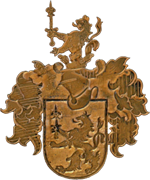The Saint King’s dynasty the Árpád dynasty
The acts of our ancestors who finally occupied the Carpathian-basin in 985 are well known. We won’t start neither from Nimrod nor from Attila, for be it true or not it would only lead us to endless dispute. Those who consider Álmos and Árpád to be the first Magyars, keep and honor their legacy, those whose eye can see further should be proud of their belief. May this give them attitude but not ostentation. The era known as the invasions, which lasted for nearly a century in the 9th and 10th century, during which we were always called in as allies by the factious local potentates. Europe to this day mentions the “barbarian Hungarians”. Less or in different light are we hearing about the campaigns of the Norman-Vikings, the conquistadors wiping out the Native Americans or about the deeds of the colonizers nearly a millennia later. Our Arpad dynasty kings are to us like the Piast dynasty to the polish, the Przemyśl to the Czech, the Capet to the French or the Liudolf to the Germans etc. They were our truthful, national, kings, chosen by the people. The dynasty’s founder Árpád defeated the joint forces of East Francia at the Battle of Pressburg in 907 AD. The leader of the army Liutpold, Margrave of Bavaria died in the battle along with archbishop Ditmar, several bishops and nearly 20 counts. Árpád and three of his sons also had fallen victim to the first patriotic war of The Carpathian homeland. Vajk, son of Gyeucsa-Géza the great-great grandchild of Árpád, the heir apparent according to tradition, went against Koppány for the throne. With completely different instruments but in their own way both of them fought for the survival and elevation of the Magyars. The millennial long debate must be closed by seeing the good in both of them and forgiving the wrong. Still to this day the finger pointing weakens our homeland’s unity, which is crucially needed. The goal of István/Vajk was to belong to the Western Christianity against the Eastern. As István he was victorious and thereafter our King László, the grandson of Vazul whom he blinded, canonized him in 1083. At the same time they also canonized his son prince Imre. In 1031 he was murdered by a boar, coincidently at the same time when with the death of his uncle Saint Henrik the 2nd the Bavarian dynasty extinct on the spear side, and his cousin Imre the last descendant on the distaff side could have inherited the crown of the Holy Roman Empire. István’s sister or daughter married the Anglo-Saxon prince Edmund, who fled from the Normans to us. Their daughter the later canonized Margit, upon returning to her homeland, she became Queen of Scotland and with her faith restored peace. We continue the line of saints with László, the knight ideal of his time, was the elected leader of the departing crusader army for the Holy Land. The crusade has been foiled by his death in 1095. His daughter was Saint Piroska (Saint Irene of Hungary) wife of John II Komnenos emperor of the Byzantine Empire and mother of the future emperor Manuel I Komnenos. She founded the Monastery Pantokrator and the 50 bed hospital attached to it. Saint Agnes of Bohemia was the daughter of King Ottokar I of Bohemia and Constance of Hungary, the daughter of King Béla III of Hungary. Both the German and English monarch proposed to her, instead she founded monasteries in Prague, first for the Conventual Franciscans later for the Poor Clares. Mainly she tended to orphans and the sick. She was canonized in 1989 by John Paul II. Saint Elizabeth of Hungary the sister of Béla IV, our second founding father after the Mongol Invasion, became the wife of Louis IV, Landgrave of Thuringia. After the death of her husband her brother-in-law treated her harshly and she left the court. Frederick II the Holy Roman Emperor proposed to her but she refused to remarry. Her niece, the daughter of Béla IV, Saint Margaret of Hungary was dedicated from her birth to God in exchange for Hungary’s liberation from the Mongols. From the age of 3 she lived in Monasteries, at first in Veszprém later in a Monastery founded by her parents on Nyulak Szigete which was later renamed after her. Both King Ottokar II of Bohemia and the King of Poland proposed to her, but she didn’t trade the heavenly kingdom for earthly treasures. Her sister Saint Kinga of Poland is the patron of Poland and Lithuania. With her husband the king of Poland Boleslav V the Chaste they took a wow of chastity. After the death of her husband she joined the Poor Clares and distributed her wealth among the poor. Saint Elizabeth of Hungary the last golden twig, daughter of Andrew III of Hungary, following her father’s death (January 1st 1301.) is brought to Vienna with her mother Agnes of Austria. She becomes the target of power interests but she chooses the monastery life. And for 28 years until her death she lives in the Swiss Monastery Töss. She refuses the repeated proposals of Henry of Austria. For years she is battling with illness but she is bearing with it humbly. At her gravesite several people have been cured.
This unconventional enumeration was mainly not compiled upon religious grounds rather it supposed to represent that how highly this dynasty was regarded in the middle ages. From the west Hungary was under constant attack. It was a pain in their necks that a nation with an ancient past is wedging in into the heart of Europe.
The ones coming from the east attacked us for the riches of Europe. For 400 years this dynasty bore this double pressure hanging constantly in the balance. In the Battle on the Marchfeld at Dürnkrut to avoid the Czech hegemony Ladislaus IV of Hungary made an alliance with Rudolph I of Habsburg against Ottokar II of Bohemia. After winning the battle we got out of the frying pan and into the fire. Ottokar’s grandmother, the daughter of Béla III of Hungary, Constance of Hungary was the ancestress of the Przemysl dynasty. The wife of Ottokar Kunigunda was the granddaughter of Béla IV and cousin of Ladislaus.
Maybe the romantic perspective makes it but for many of us they live in our hearts as our own true leaders and kings. Even with their mistakes they served the elevation of the Magyars. Hopes were sparked in their direct descendants the Anjous and once more during the time of Matthias Corvinus, but they faded utterly.



